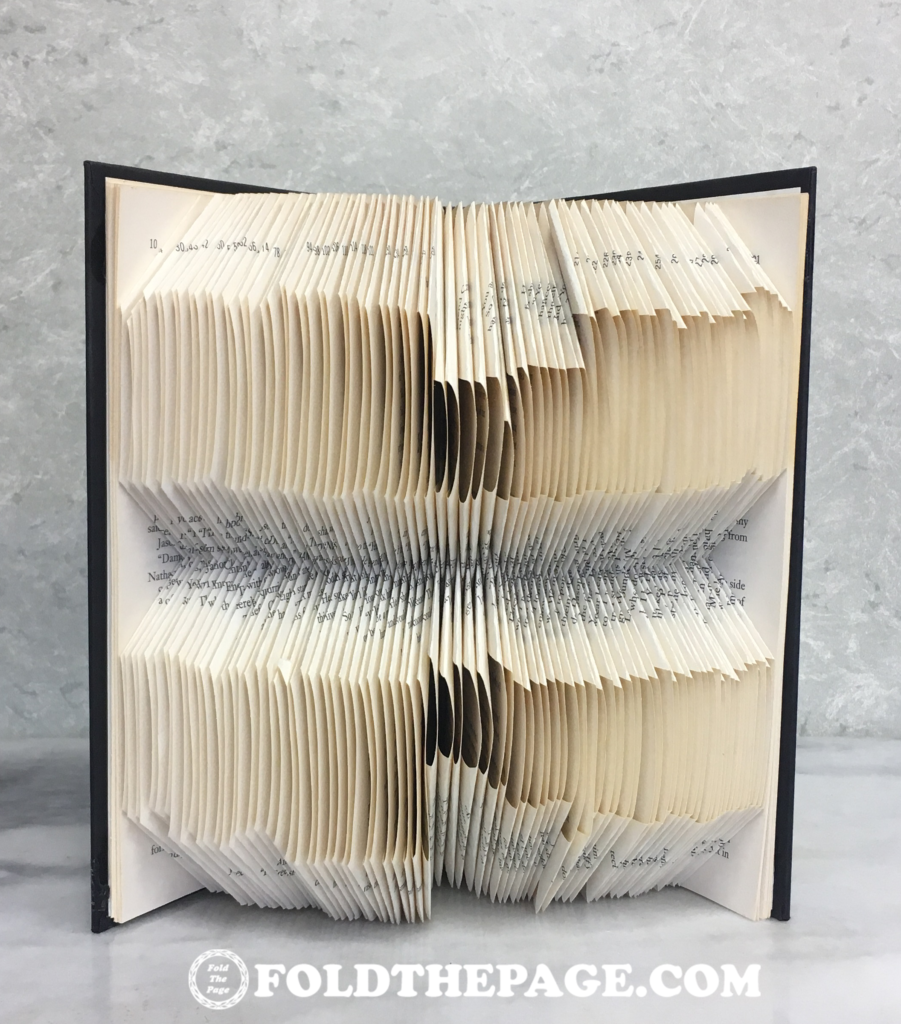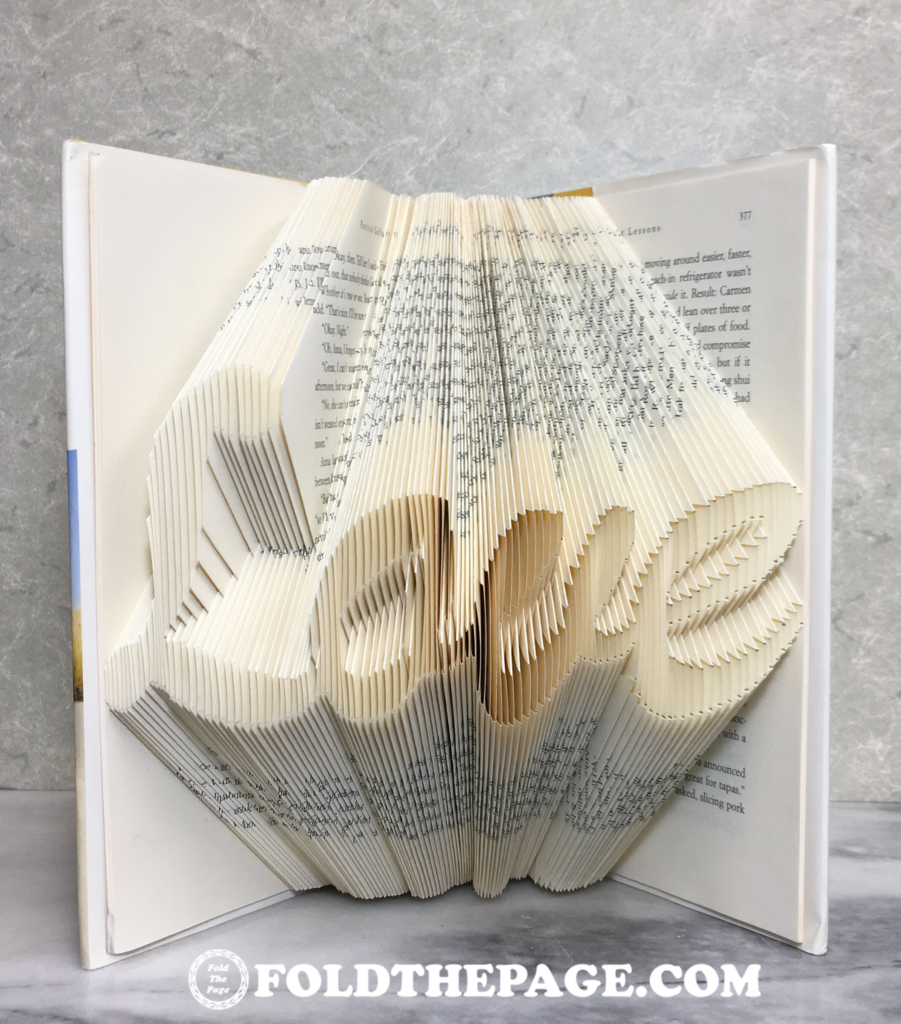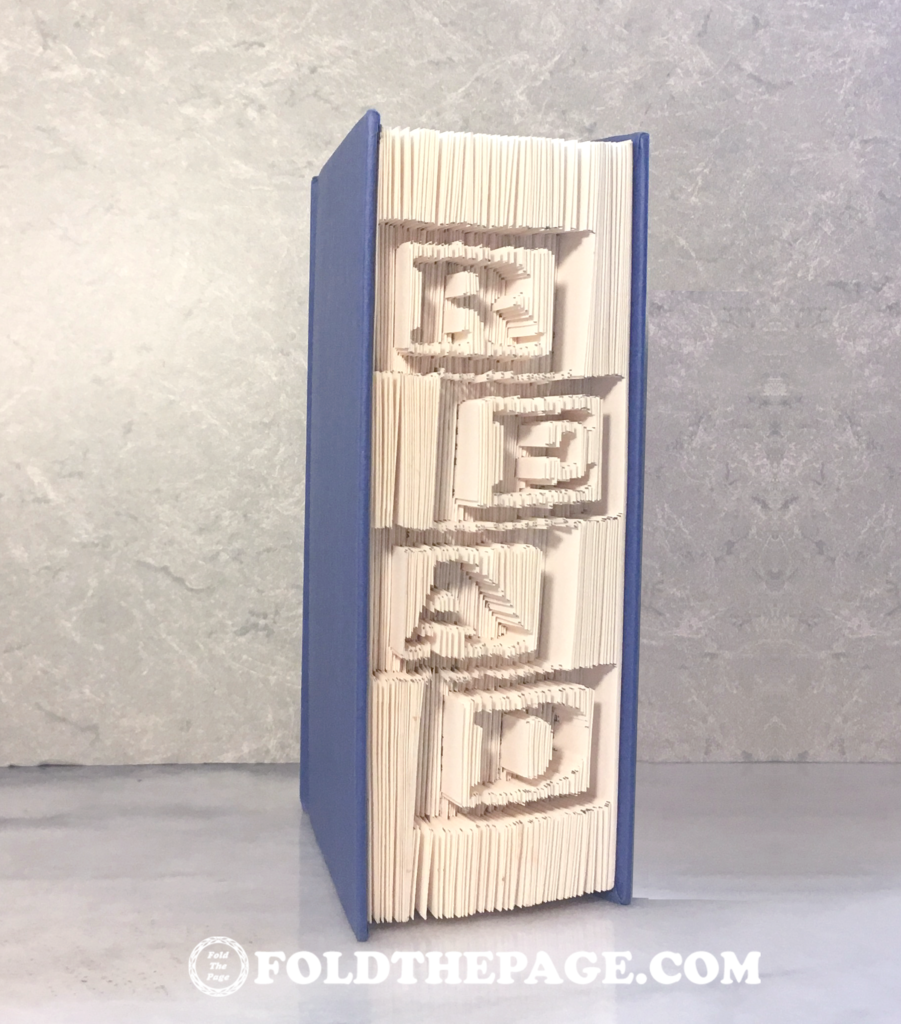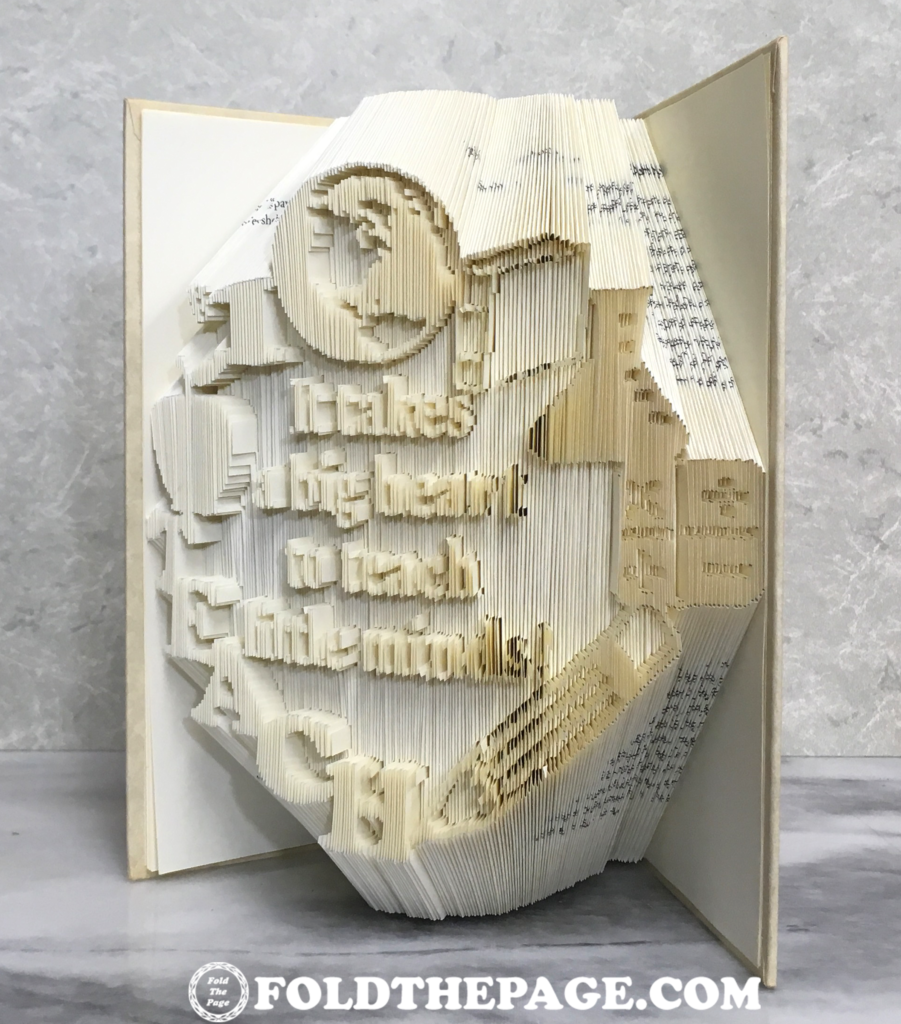What is Book Folding?
Officially book folding is when a publisher folds the pages of a book after they’re printed but before binding them into the book. For our purposes, book folding is a bit more artsy. It is the process of folding down the page of a book to create a sculpture, in the same basic way that painting is the process of brushing paint onto a canvass. As painting has many different mediums; acrylic, oil, watercolor, etc…book folding has subcategories as well based on the technique used to create the sculpture.
I’ve divided these into categories based on the number of processes involved in creation.
Abstract Shapes/Inkblot have one stage of production, Fold (Only) Designs have two, Cut&Fold Designs have three, and Cut&Fold Combination Designs have four. We’ll start with the first category.
Abstract Shapes and Inkblots

These are the rectangles, the prisms, the octagonal castles, and the inkblot type shapes that come from sitting down with a book, and folding the pages whichever way you want. This category involves the single process of folding. Now while most of the prism type shapes do
have a pattern – you alternate every other page folded up or down for example – the inkblots are exactly what they sound
like. You fold every page whichever random way you want and voila, you have an inkblot. This used to be a fun exercise in elementary school where kids would take old Reader’s Digest books and fold them into inkblots or simply Christmas trees. They’re cute, but like cave paintings evolved into impressionistic masterpieces, book folding has come a long way since then too.
Fold (Only)
 These designs are the popular words or defined shapes like hearts or stars. It involves two processes: marking and folding. These definitely need a pattern and involve marking all the pages before you can even get to the folding part. Once you’ve got your pattern, you’ll mark every single page of the book so you know where you are going to fold. Then, once your book is marked, you can begin folding every single page at those pre-penciled
These designs are the popular words or defined shapes like hearts or stars. It involves two processes: marking and folding. These definitely need a pattern and involve marking all the pages before you can even get to the folding part. Once you’ve got your pattern, you’ll mark every single page of the book so you know where you are going to fold. Then, once your book is marked, you can begin folding every single page at those pre-penciled  marks. Each page will only have two marks, and you will fold up or down at as close to a 90° angle as possible from those marks to create your sculpture.
marks. Each page will only have two marks, and you will fold up or down at as close to a 90° angle as possible from those marks to create your sculpture.
(Note: Sometimes a 90° angle isn't possible without folding the page over itself into the spine of the book. In this case you'll fold inward only until the corner of the page barely touches the inner spine of the book, and fold. For more detailed instructions, check out our free tutorial under the Downloads tab.)
These next two categories enter into the shadowy field of actually cutting the pages of a book. I know, all book lovers everywhere just cringed. For the first two categories you can excuse your literary blasphemy by insisting that you’re not actually harming the book, it’s just folding. If you really wanted you could always unfold the pages and read the book again. But from this point on, that is not true, so make sure you are choosing a book you don’t mind cutting.
Cut & Fold
 Like the name suggests, Cut&Fold Book Folding involves not only folding the pages, but cutting them as well. These also need patterns, but unlike the Word Category above, you do not mark every single page. Instead, you mark every other page. This is because the pages you leave blank are known as inset pages and are used to thicken your finished book. Also unlike with the Fold Only category, you will be making more than two marks per page. Depending on the intricacy of your pattern you could have anywhere from six to thirty marks per page. Once you’ve finished marking every other page, you can start the cutting process where you cut every single mark you made on the marked pages. Every cut is made at the same depth into the book to ensure a consistency in the design. You can do this by either measuring with a ruler, or making a mark on your scissors. Once all the marked pages are cut, you move on to folding.
Like the name suggests, Cut&Fold Book Folding involves not only folding the pages, but cutting them as well. These also need patterns, but unlike the Word Category above, you do not mark every single page. Instead, you mark every other page. This is because the pages you leave blank are known as inset pages and are used to thicken your finished book. Also unlike with the Fold Only category, you will be making more than two marks per page. Depending on the intricacy of your pattern you could have anywhere from six to thirty marks per page. Once you’ve finished marking every other page, you can start the cutting process where you cut every single mark you made on the marked pages. Every cut is made at the same depth into the book to ensure a consistency in the design. You can do this by either measuring with a ruler, or making a mark on your scissors. Once all the marked pages are cut, you move on to folding.
Unlike an abstract shape, or a word where you only fold each page twice, with a Cut&Fold you may wind up folding a single page 16 times. It all depends on the pattern. Basically, you look at your marked/cut pages, you start at the top and fold every other section inward. On the next page, a blank page if you did everything right, you will fold the entire page inward at the same depth as the cut page before. You want to make sure the folded sections of the cut page, and the fold of the blank page match the depth they are folded. Now, rinse and repeat for the entire book and you have a Cut&Fold Book Sculpture. The main draw for Cut&Fold’s are the more intricate designs you can create by cutting the pages. Personally, I prefer Cut&Fold Combination sculptures over the simple Cut&Fold.
Cut & Fold Combination
 This category combines the Fold Only Category with the Cut&Fold Category. Like the Fold Only Category you will mark and fold every single page, but like the Cut&Fold Category, there will be more than two marks and folds per page. The Process goes like this; you get your pattern and mark every single page. Then you go through the entire book and fold the top and bottom of every page upward or downward at a 90 degree angle – just like you would a word or heart. Once every page is folded you get out your scissors – I prefer spring loaded thread scissors – and you cut all the inner marks - the marks
This category combines the Fold Only Category with the Cut&Fold Category. Like the Fold Only Category you will mark and fold every single page, but like the Cut&Fold Category, there will be more than two marks and folds per page. The Process goes like this; you get your pattern and mark every single page. Then you go through the entire book and fold the top and bottom of every page upward or downward at a 90 degree angle – just like you would a word or heart. Once every page is folded you get out your scissors – I prefer spring loaded thread scissors – and you cut all the inner marks - the marks  between the two folds – on every single page at the same depth. After each page is cut, you are on to the last process, the inner folding. This is where, starting at the top of every page, you fold every other section inward to create your three-dimensional sculpture.
between the two folds – on every single page at the same depth. After each page is cut, you are on to the last process, the inner folding. This is where, starting at the top of every page, you fold every other section inward to create your three-dimensional sculpture.
That’s it! Book Folding in a Nutshell. Now hopefully I’ve done such an engaging job of explaining that you all want to go out and try it yourselves, and that’s fantastic! I recommend beginning with a heart or other simple shape. If you are brand new to book folding, check out our free downloads page for tutorials and our specially designed printable ruler.
Our Etsy shop, foldthepagepatterns.etsy.com, is full of Patterns for sale, all digital downloads that include a free tutorial as well as a free practice pattern to get you started on your folding journey.
If the entire process sounds cool, but way to time consuming for you, that’s ok. We also sell the finished sculptures on our sculpture etsy shop at foldthepage.etsy.com. They make great gifts for all book lovers or that person you wind up wracking your mind trying to find out what to get them every year at Christmas.
I hope this has been both fun and explanatory and let me be the first among the many of book folders out there to welcome you to the world of book folding!